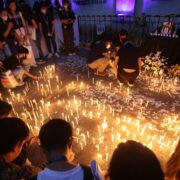Amorsolo: Chroma

What more can one say or show about Fernando Amorsolo, the first National Artist of the Philippines, that deserves a second look? I thought the answer to my question was—nothing. Then I saw photos of people at the current Ayala Museum exhibition, “Amorsolo: Chroma.” Adults were busy with crayons, painting by numbers on low tables that reminded me of kindergarten. When I visited the exhibit, I realized that emerging museum curators, led by Tenten Mina, brought the old master into the 21st century through interactive technology. It wasn’t a ho-hum but a wow for me, trying out different digital stations that show how Amorsolo used color in the paintings displayed in the next room. There was even a station on Color Vision Deficiency that made me accept that I am color-blind. No, I don’t see the world in black and white; rather, I perceive certain colors differently. I am red-green color-blind.
Years ago, while renewing my driver’s license, I was asked to read out numbers or letters in a circle filled with a sea of colored dots. The technician was drawing on the picture with his index finger, prompting me to complain, “You are wasting my time, please sign the clearance so I can get my license.” She was trying to help me by drawing out the numbers and letters I could not see, even if I tried. When she declared me color-blind, I snapped: “I can see red, yellow, and green on a stoplight and know what these colors mean, so what is our problem?” I got the clearance but was advised to bring a medical certificate next time stating that I was fit to drive.
I obviously see color differently from Amorsolo, but this exhibit made me appreciate why the master is heralded as the “painter of Philippine sunlight.” Amorsolo gave us a world dappled in light, a carefree, innocent world forever changed by the Second World War and postwar politicians who created today’s ills. There is a room divider from the Luis Ma. Araneta Collection composed of many small landscapes by Amorsolo—a lost world to us in the 21st century. Amorsolo’s best works are those done before the war, especially in the 1920s and 1930s when the Philippines was undergoing sociocultural ferment. English was replacing Spanish as the language of the government, power, and fashion. The last vestiges of our Spanish heritage—our connection with Europe—were slowly swept away by an efficient public school system that emphasized Americanism rather than Filipinism.
Fortunately, politics was only one of many pastimes in prewar or “peacetime” Manila. It was the era of the Manila Carnival in February and the kundimans of Nicanor Abelardo and Francisco Santiago. Honorata “Atang” de la Rama was the queen of the zarzuela, which competed with film, once silent or mute, until the pictures learned to talk. While Amorsolo was busy with carnival posters, ads for Ivory soap, and iconic trademarks like Ginebra San Miguel, his friend and counterpart Guillermo E. Tolentino was doing commercial illustration on the side. Tolentino was busy molding statues for mausoleums, capturing the beauty of carnival queens in plaster of Paris busts, and of course finishing his iconic monument to Andres Bonifacio in Caloocan, in a rotunda, now referred to as “Monumento.”
Amorsolo’s paintings in this exhibition show us a world that is no more. Where are the “lavanderas,” clad sensuously, toiling in clear, bubbling brooks and rivers? Where are the husky farmers dressed in red kundiman pants and white camisa de chino that we associate with Andres Bonifacio and the Katipunan. Then there are Amorsolo’s idealized Filipinas: beautiful, virginal, merry women at work in the fields or market stalls. They are fresh as their produce and don’t seem to perspire or burn in the sun. In Amorsolo’s canvases, we see Arayat or Mayon in the background, in compositions so happy, even the carabaos—while beasts of burden—smile.
Idyllic scenes of Philippine life were in every Filipino home—as original canvases in the homes of the rich, or as calendars, posters, postage stamps, and tourist brochures reproduced in the thousands for those of more modest means. Amorsolo remains a blue-chip art investment. His paintings may not spike or draw the eight-figure sums of contemporary artists in the current overheated Manila auction scene, but his price remains stable. His work continues to be desirable, prompting copies and forgeries to this day.
The paintings in this exhibition, drawn from public and private collections, were carefully chosen for authenticity and quality. You may not see these works all under one roof ever again, so do visit while the show is up to look into the past captured and repeated by Amorsolo ad nauseam even when his eyes failed and his hand became unsteady, requiring the help of assistants in his declining years. As a historian, I marvel at the way Amorsolo captured the spirit of an age, freezing it on canvas for later generations to admire and aspire for. We can never return to Amorsolo’s pastoral Philippines, but we can, in our imagination and his paintings and drawings.
Ambeth is a Public Historian whose research covers 19th century Philippines: its art, culture, and the people who figure in the birth of the nation. Professor and former Chair, Department of History, Ateneo de Manila University, he writes a widely-read editorial page column for the Philippine Daily Inquirer, and has published over 30 books—the most recent being: Martial Law: Looking Back 15 (Anvil, 2021) and Yaman: History and Heritage in Philippine Money (Bangko Sentral ng Pilipinas, 2021).


















